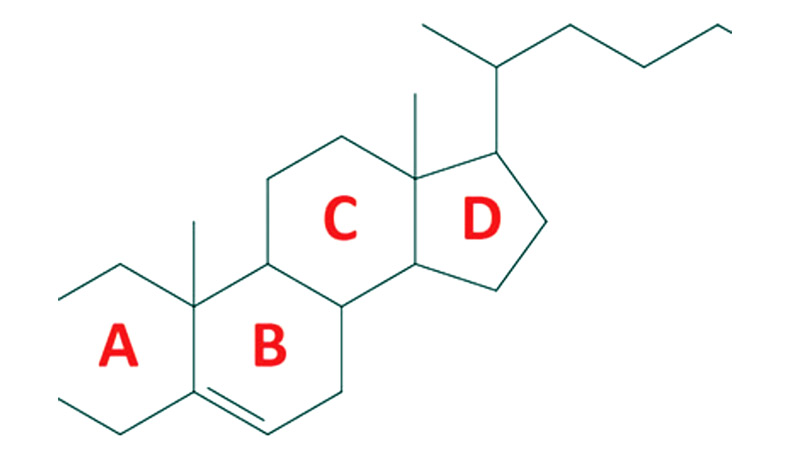Cholesterol is a vital component of the human body, playing crucial roles in cell membrane structure, hormone synthesis, and bile acid production. Its presence and regulation are fundamental for various physiological processes.
This article aims to delve into the biochemistry of cholesterol, including its synthesis, transport, degradation, and its implications on overall health.
 Cholesterol is a sterol, a specific type of lipid molecule characterized by a multi-ringed structure. It is primarily synthesized in the liver and, to a lesser extent, in other tissues such as the intestines, adrenal glands, and reproductive organs.
Cholesterol is a sterol, a specific type of lipid molecule characterized by a multi-ringed structure. It is primarily synthesized in the liver and, to a lesser extent, in other tissues such as the intestines, adrenal glands, and reproductive organs.
The synthesis of cholesterol begins with the conversion of the molecule acetyl-CoA to mevalonate, which is catalyzed by the rate-limiting enzyme HMG-CoA reductase. This enzyme is highly regulated at the transcriptional and post-transcriptional levels to maintain cholesterol homeostasis.
SREBPs
The synthesis of cholesterol is primarily regulated by a complex feedback mechanism mediated by a family of transcription factors called sterol regulatory element-binding proteins (SREBPs). When intracellular cholesterol levels are low, SREBPs are activated and migrate to the nucleus, where they bind to specific DNA sequences known as sterol regulatory elements (SREs).
This binding leads to the upregulation of genes involved in cholesterol synthesis, including HMG-CoA reductase, promoting an increase in cholesterol production. Conversely, when intracellular cholesterol levels are high, SREBPs are inactivated, resulting in the downregulation of cholesterol biosynthesis genes, thereby reducing cholesterol production.
After synthesis, cholesterol is converted into various metabolites essential for the functioning of the body. One key pathway is the production of bile acids, which play a crucial role in the digestion and absorption of dietary fats. In the liver, cholesterol is converted into primary bile acids, such as cholic acid and chenodeoxycholic acid.
These bile acids are then conjugated with an amino acid, glycine or taurine, to form bile salts. Bile salts are stored in the gallbladder and released into the small intestine when fat is present, aiding in the emulsification and digestion of dietary fats.
Precursor
Cholesterol also serves as the precursor for the synthesis of steroid hormones, including glucocorticoids, mineralocorticoids, and sex hormones like estrogen, progesterone, and testosterone.
These hormones are vital for various physiological processes, such as regulating salt and water balance, mediating the body’s stress response, and controlling reproductive functions. The conversion of cholesterol into these hormones occurs primarily in the adrenal glands and gonads, with different enzymes and regulatory pathways being involved.
The transport of cholesterol is another essential aspect of its biochemistry. Since cholesterol is not water-soluble, it requires specialized carriers known as lipoproteins for transport within the bloodstream.
The two main types of lipoproteins involved in cholesterol transport are low-density lipoprotein (LDL) and high-density lipoprotein (HDL). LDL carries cholesterol from the liver to peripheral tissues, where it is taken up by cells through LDL receptors.
Excessive LDL levels can lead to the accumulation of cholesterol in the arteries, contributing to the development of atherosclerosis. On the other hand, HDL scavenges cholesterol from peripheral tissues and transports it back to the liver for excretion, earning it the reputation of the “good” cholesterol.
Cholesterol balance in the body is also regulated by its degradation mechanism. One significant pathway involves the conversion of cholesterol into bile acids through a series of enzymatic reactions collectively known as the classic pathway.
Alternative pathway
Another pathway, called the alternative pathway, involves the conversion of cholesterol into oxysterols, such as 27-hydroxycholesterol, which serve as potent regulators of cholesterol synthesis and metabolism. Imbalances in cholesterol metabolism can lead to various diseases.
High levels of LDL cholesterol, often referred to as “bad” cholesterol, are a major risk factor for the development of cardiovascular disease, including heart attacks and strokes. Conversely, low levels of HDL cholesterol are associated with an increased risk of cardiovascular disease.
Disorders in cholesterol synthesis or degradation pathways can also lead to rare genetic diseases, such as familial hypercholesterolemia and Smith-Lemli-Opitz syndrome. In brief, cholesterol is an essential molecule in the human body, being involved in various physiological processes. Its synthesis, transport, and metabolism are tightly regulated to maintain cholesterol homeostasis.




